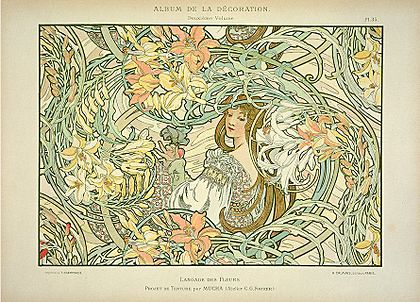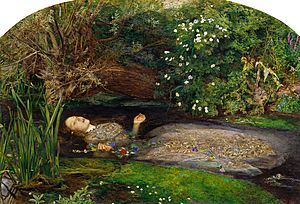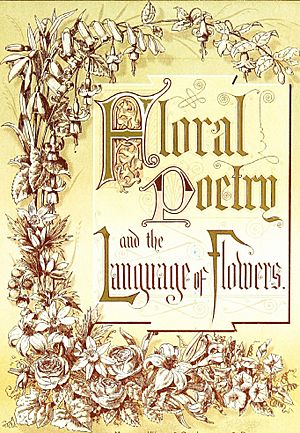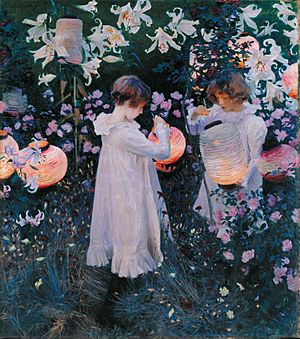Language of flowers facts for kids

Floriography, also known as the language of flowers, is a special way of communicating using flowers. People have given meanings to flowers for thousands of years. Different cultures in Europe, Asia, and Africa have used flowers to send secret messages. For example, in the Hebrew Bible, flowers and plants are used as symbols of love and even for important people.
This idea of flower language became super popular in Victorian England and the United States during the 1800s. People would give gifts of flowers, plants, or special flower arrangements to send a hidden message. This was a way to express feelings that were too shy or not allowed to be spoken out loud in Victorian society. People even used "floral dictionaries" to understand these messages! They would often exchange small "talking bouquets" called nosegays or tussie-mussies. These tiny bouquets could be worn or carried as a cool fashion accessory.
Contents
The History of Flower Language
The renewed interest in the language of flowers during the Victorian era actually started in Ottoman Turkey. Specifically, it began in the court of Constantinople (modern-day Istanbul) in the early 1700s, where people were obsessed with tulips.
This flower craze came to Europe thanks to an Englishwoman named Mary Wortley Montagu. She brought the idea to England in 1717. Soon after, the first books linking flowers to symbolic meanings started to appear. One of the first was by Joseph Hammer-Purgstall in 1809. Then, in 1819, Louise Cortambert (writing as Madame Charlotte de la Tour) wrote a very important book called Le langage des Fleurs (The Language of Flowers).
In the United States, the language of flowers first appeared in print in the 1820s. Elizabeth Wirt's Flora's Dictionary and Dorothea Dix's The Garland of Flora were two of the first books on this topic, both published in 1829. Many popular writers and editors in the US also became interested. For example, Sarah Josepha Hale, a famous editor, put together Flora's Interpreter in 1832, which was printed for many years.
What Flowers Mean
The meanings given to specific flowers could change a lot. Almost every flower had several different meanings listed in the many floral dictionaries. However, some common meanings became widely accepted. Often, a flower's meaning came from how it looked or behaved.
For example, the mimosa plant, also called the sensitive plant, stands for shyness or purity. This is because its leaves close up at night or when you touch them.
The deep red rose is a strong symbol of intense romantic love. Its thorns can also represent challenges. Pink roses often mean a lighter affection, while white roses suggest purity and honesty. Yellow roses are usually a sign of friendship or devotion. A black rose (which is actually a very dark red, purple, or maroon, or sometimes dyed) can be linked to death or darkness because of its color.
People in Victorian times were very specific about how they wore flowers. If a suitor (someone trying to win a person's affection) sent a small bouquet called a tussie-mussie, where it was worn mattered. If it was pinned near the chest, it meant friendship. But if it was pinned right over the heart, that was a clear sign of love!
Later on, people even created lists that linked a specific flower to each day of the year, like a birthday flower.
Flowers in Literature
Many famous writers have used the language of flowers in their stories and poems. These include William Shakespeare, Jane Austen, Charlotte and Emily Brontë, and children's author Frances Hodgson Burnett.
Shakespeare used the word "flower" over 100 times in his plays and sonnets. In his play Hamlet, a character named Ophelia talks about the symbolic meanings of flowers and herbs as she gives them to others. She mentions pansies, rosemary, fennel, lilies, columbine, rue, and daisy. She also sadly notes that she has no violets because they "wither'd all when my father died."
Even in modern literature, flower language appears. In J. K. Rowling's 1997 novel Harry Potter and the Philosopher's Stone, Professor Severus Snape uses the language of flowers. According to Pottermore, he uses it to show his sadness and regret for the death of Lily Potter, who was his childhood friend and Harry Potter's mother.
Flowers are also often used to symbolize femininity. John Steinbeck's short story "The Chrysanthemums" focuses on yellow chrysanthemums, which can represent optimism or lost love. When the main character, Elisa, finds her beloved chrysanthemums thrown away, it shows how her hobby and sense of womanhood have been hurt.
Flowers in Art
Artists have also used flowers to add deeper meaning to their work. The Victorian Pre-Raphaelites were a group of 19th-century painters and poets. They wanted to bring back the pure art style of the late medieval period. These artists were known for showing women in an ideal way, focusing on nature and morality, and using ideas from literature and mythology. Flowers full of symbolism were very important in many of their paintings.
John Everett Millais, one of the founders of the Pre-Raphaelite group, used oils to create paintings with lots of natural details and rich flower symbolism. His painting Ophelia (1852) shows Shakespeare's character Ophelia floating in water among the very flowers she talks about in Hamlet.

The Edwardian artist John Singer Sargent often painted outdoors in the English countryside and frequently used flower symbolism. Sargent's first big success was in 1887 with Carnation, Lily, Lily, Rose. This large painting shows two young girls lighting lanterns in an English garden.
Contemporary artist Whitney Lynn created a special art project for the San Diego International Airport using floriography. She used flowers to communicate messages that might otherwise be hard or restricted to say out loud. Lynn also created a piece called Memorial Bouquet. This work used flower symbolism based on Dutch Golden Age still-life paintings. The flowers in her arrangement represented countries where the United States military has been involved in operations or conflicts.
See also
- Hanakotoba – Japanese flower language
- Plant symbolism
- Floral emblem
- Sub rosa



